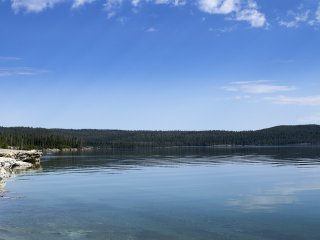Water Quality Benefits Grants

EPA awarded $3 million for research to estimate the benefits of water quality improvements on under-studied regions, underrepresented waterbody types.
Across the United States, waterbodies affect the quality of life for people and the environment overall. The beneficial impacts of waterbodies in healthy condition can be surprisingly far-reaching. Benefits include higher property values and less expensive water treatment costs, but also include quality outdoor recreational uses such as beach going, swimming, boating and wildlife viewing.
National, state, and local management actions can affect a variety of waterbodies across spatial scales that lead to a broad range of benefits for different communities or population groups. Quantifying these benefits can support regulatory impact analyses and state, tribe, and local water quality decision-making.
The research projects funded with these awards will address how measurable attributes of water quality improvements can be valued, either directly or through indicators. The research teams will focus on ways to expand water quality valuation to cover gaps in terms of geographic coverage, waterbody types and distributional effects. In addition, these funded grants will research how best to value tradeoffs between improving water quality significantly in a few waters versus improving water quality modestly in many waters.
University of Minnesota
Award Amount: $742,000
Principal Investigator: Bonnie Keeler
Project Title: Investigating the Distribution and Value of Water Quality Benefits Along the Mississippi River
Project Summary:
The study evaluates how insights from methods such as online surveys and social media analysis, along with different disciplinary perspectives, lead to alternative policy conclusions across equity and efficiency objectives. Activities include administration of a non-market valuation survey to residents along the Mississippi River to evaluate how perceptions and willingness to pay for water quality benefits vary across socioeconomic and geographic scales. To expand participation in surveys, the team will use novel methods to recruit survey participants including social media data and mobile technologies. In addition, researchers will visit multiple Mississippi River cities including historically-marginalized and low-wealth communities to engage with and learn from these communities and document community priorities related to the River.
View the research abstract for this project.
University of Wisconsin
Award Amount: $741, 864
Principal Investigator: Daniel Phaneuf
Project Title: Valuing Water Quality Improvements in Nationwide Ecosystems: Total Value Based on the Biological Condition Gradient
Project Summary:
The study seeks to provide insight on the extent of the market, willingness to pay (WTP), and whether WTP differences exist between local and regional scales. The project also seeks to develop data and models to quantify a “Biological Condition Gradient (BCG)” in watersheds by using stated and revealed preference surveys across the country. Biological index data from state, tribal, and local environmental agencies will be assembled to predict place-specific baseline BCG scores and integrate these into the survey protocols. Once completed, the researchers will apply the benefit functions from surveys in a national Integrated Assessment Modeling (IAM) framework to consider the efficiency and distributional consequences of potential policy actions.
View the research abstract for this project.
University of Texas at Austin
Award Amount: $741, 054
Principal Investigator (PI): Sheila Olmstead
Project Title: Estimating the Missing Benefits of Water Quality by Nesting Recreation Demand and Hedonic Modeling
Project Summary:
This project focuses on developing models to determine the impacts of water quality changes on property values by studying three larger coastal areas with iconic waterbodies including Puget Sound, Long Island Sound, and the Texas Gulf Coast. The research team will implement a two-stage econometric model of recreation and housing demand to evaluate the recreational and amenity value of water quality changes in the three regions. The team will also compare estimates across waterbody types, regions, and socioeconomic characteristics of property owners and people participating in outdoor activities.
View the research abstract for this project.
University of Missouri
Award Amount: $740,014
Principal Investigator (PI): Rebecca North
Project Title: Valuing Water Quality Improvements in Heartland Reservoirs
Project Summary:
The team will assess willingness to pay (WTP) for water quality improvements in Midwestern reservoirs. Researchers will be measuring linkages between water quality and the provision of ecosystem services to inform potential scenarios and ecosystem attributes. WTP will be measured by incorporating choice experiments to determine impacts of water quality restoration along with scenarios and accounting for ecosystem services bundling. Last, demographic and spatial characteristics will be evaluated which may inform the extent to which water quality changes impact WTP.
